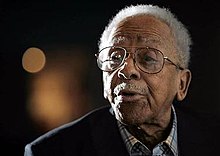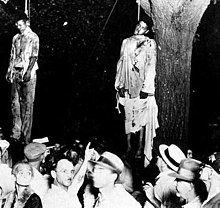| James Cameron | |
|---|---|
 | |
| Born | (1914-02-15)February 15, 1914 La Crosse, Wisconsin, United States |
| Died | June 11, 2006(2006-06-11) (aged 92) Milwaukee, Wisconsin, United States |
| Occupation | Political activist |
| Years active | 1940–2006 |
| Known for | Surviving an attempted lynching |
| Notable work | Founding America's Black Holocaust Museum |
| Spouse |
Virginia Hamiliton (m. 1938) |
| Children | 5 |
James Cameron (February 25, 1914 – June 11, 2006) was an American civil rights activist. In the 1940s, he founded three chapters of the National Association for the Advancement of Colored People (NAACP) in Indiana. He also served as Indiana's State Director of the Office of Civil Liberties from 1942 to 1950.
In the 1950s he moved with his family to Milwaukee, Wisconsin, where he continued as an activist and started speaking on African-American history. In 1988 he founded America's Black Holocaust Museum in the city, devoted to African-American history from slavery to the present.
Cameron was a survivor of a lynching attempt, which occurred when he was a 16-year-old suspect in a murder/robbery case in Marion, Indiana; two older teenagers were killed by the mob.
Early life and education
Cameron was born February 25, 1914, in La Crosse, Wisconsin, to James Herbert Cameron and Vera Carter. After his father left the family, they moved to Birmingham, Alabama, and then to Marion, Indiana. When James was 14, his mother remarried.
Arrest and attempted lynching
Main article: Lynching of Thomas Shipp and Abram Smith
In August 1930, when Cameron was 16 years old, he had gone out with two older teenage African-American friends, Thomas Shipp and Abram Smith. People said they attempted to rob a young white man, Claude Deeter, and killed him. Initial reports said that Shipp and Smith raped Deeter's girlfriend, Mary Ball, who was with him at the time, although she later denied it. Cameron said he ran away before the man was killed.
The three youths were caught quickly, arrested, and charged the same night with robbery, murder and rape. A lynch mob broke into the jail where Cameron and his two friends were being held. According to Cameron's account, a lynch mob of 12,000–15,000 at the Grant County Courthouse Square took all three youths from the jail. The lynch mob killed the older two first: they took Shipp out of the cell and beat him, and hanged him from the bars of his jail window; Smith was dead from beating before the mob hanged both the boys from a tree in the square. The mob beat Cameron and put a noose around his neck; before he was hanged, the voice of an unidentified woman intervened, saying that he was innocent. Frank Faunce, a local sports hero and football All-American from Indiana University, intervened and removed the noose from Cameron's neck, saying he deserved a fair trial. Faunce escorted the young man to a return to the jail. The rope scarred Cameron's neck; years later, he bought a piece of it.
Flossie Bailey, a local NAACP official, and the State Attorney General worked to gain indictments against leaders of the mob in the lynchings but were unsuccessful. No one was ever charged in the murders of Shipp and Smith, nor the assault on Cameron.
Cameron was convicted at trial in 1931 as an accessory before the fact to the murder of Deeter, and served four years of his sentence in a state prison. After he was paroled, he moved to Detroit, Michigan, where he worked at Stroh Brewery Company and attended Wayne State University.
In 1991, Indiana governor Evan Bayh pardoned Cameron.
Career
Cameron studied at Wayne State University to become a boiler engineer and worked in that field until he was 65. At the same time, he continued to study lynchings, race, and civil rights in America and trying to teach others.
Because of his personal experience, Cameron dedicated his life to promoting civil rights, racial unity, and equality. While he worked in a variety of jobs in Indiana during the 1940s, he founded three chapters of the National Association for the Advancement of Colored People (NAACP). This was a period when the Ku Klux Klan was still active in the Midwest, although its numbers had decreased since its peak in the 1920s. Cameron established and became the first president of the NAACP Madison County chapter in Anderson, Indiana.
He also served as the Indiana State Director of Civil Liberties from 1942 to 1950. In this capacity, Cameron reported to Governor of Indiana Henry Schricker on violations of the "equal accommodations" laws designed to end segregation. During his eight-year tenure, Cameron investigated more than 25 incidents of civil rights infractions. He faced violence and death threats because of his work.

Civil rights activism

By the early 1950s, the emotional toll of threats led Cameron to search for a safer home for his wife and five children. Planning to move to Canada, they decided on Milwaukee when he found work there. There Cameron continued his work in civil rights by assisting in protests to end segregated housing in the city. He also participated in two marches on Washington in the 1960s, the 1963 March on Washington for Jobs and Freedom and the 1968 Solidarity Day, part of the Poor People's Campaign.
Cameron studied history on his own and lectured on the African-American experience. From 1955 to 1989 he published hundreds of articles and booklets detailing civil rights and occurrences of racial injustices, including "What is Equality in American Life?"; "The Lingering Problem of Reconstruction in American Life: Black Suffrage"; and "The Second Civil Rights Bill". In 1982 he published his memoir, A Time of Terror: A Survivor's Story.
America's Black Holocaust Museum
Main article: America's Black Holocaust MuseumAfter being inspired by a visit with his wife to the Yad Vashem memorial in Israel, Cameron founded America's Black Holocaust Museum in 1988. He used material from his collections to document the struggles of African Americans in the United States, from slavery through lynchings, and the 20th-century civil rights movement. When he first started collecting materials about slavery, he kept it in his basement. Working with others to build support for the museum, he was aided by philanthropist Daniel Bader.
The museum started as a grassroots effort and became one of the largest African-American museums in the country. In 2008, the museum closed because of financial problems. It reopened on Cameron's birthday, February 25, 2012, as a virtual museum. It reopened as a physical museum on February 25, 2022.
Personal life
Cameron and his wife, Virginia Hamilton, had five children. He died on June 11, 2006, at the age of 92, from congestive heart failure. He was a devout Catholic and is buried at Holy Cross Cemetery in Milwaukee. Two sons, David and James, had died before him. He was survived by his wife Virginia and three children: Virgil, Walter, and Dolores Cameron, and numerous grandchildren and great-grandchildren.
Legacy and honors
- PBS Wisconsin produced a documentary entitled A Lynching in Marion.
- Marion, Indiana presented Cameron with a key to the city.
- Cameron was interviewed by BBC, and Dutch and German television.
- In 1999 Cameron was awarded an honorary doctorate by the University of Wisconsin–Milwaukee.
- Milwaukee added his name to four blocks of West North Avenue, from North King Drive to North 7th Street.
Published works
- Cameron, James. A Time of Terror: A Survivor’s Story, self-published, 1982; reprinted Black Classics Press, 1994.
References
- ^ Lamb, Yvonne Shinhoster (June 12, 2006). "Obituary of James Cameron". Washington Post. Retrieved July 14, 2008.
- ^ Thomas-Lester, Avis (June 11, 2005). "75 years later, scars still linger". The Washington Post. Retrieved January 18, 2024.
- ^ Bradley, David (May 24, 2006). "Anatomy of a Murder: Review of Cynthia Carr's Our Town". The Nation. Retrieved September 6, 2015.
- Little, Monroe H. "Review of James Madison's A Lynching in the Heartland". History-net. Archived from the original on July 8, 2007. Retrieved June 11, 2014.
- ^ "James Cameron Holocaust Museum founder". African American Registry. 2006. Retrieved July 15, 2008.
- Lowe, Frederick H. (May 30, 2002). "Life Stories: He Survived a Lynching, Now He Won't Let Us Forget". Chicago Reader. Retrieved October 10, 2024.
- "Our Founder", America's Black Holocaust Museum, accessed 15 July 2008
- Widen, Larry (May 31, 2023). "Who's Buried in Milwaukee?". Shepherd Express. Retrieved April 18, 2024.
- ^ Meg Jones, Leonard Sykes, Jr., and Amy Rabideau Silvers, "Cameron brought light to racial injustices", Milwaukee Sentinel Journal, 11 June 2006, accessed 15 July 2008
- "Dr. Cameron: Founder Lynching Survivor". America's Black Holocaust Museum. Retrieved February 5, 2022.
- "Director of America's Black Holocaust Museum to Speak at MSU", Michigan State University News, 11 September 2003, accessed 15 July 2008 Archived 12 May 2009 at the Wayback Machine
- Sandler, Larry (August 30, 2006). "Street could be renamed for good Samaritan who died". Milwaukee Journal Sentinel.
Further reading (most recent first)
- Carr, Cynthia, Our Town: A Heartland Lynching, A Haunted Town, and the Hidden History of White America, Random House, 2007.
- Allen, James; Als, Hilton (2000). Without Sanctuary: Lynching Photography in America. Twin Palms Publishers. Archived from the original on March 8, 2012.
- Tolnay, Stewart E. and E. M. Beck, A Festival of Violence: An Analysis of Southern Lynchings, 1882–1930 (Urbana: University of Illinois Press, 1992)
External links
- America's Black Holocaust Museum
- "Obituary of James Cameron" - Washington Post
- James Cameron's oral history video excerpts, The National Visionary Leadership Project
- David J. Marcou. "Challenger & Nurturer: Wisconsin Civil Rights Pioneer James Cameron (1914-2006)" Archived July 27, 2011, at the Wayback Machine, La Crosse History
- African-American non-fiction writers
- Activists for African-American civil rights
- Lynching survivors
- Crimes in Indiana
- Wayne State University alumni
- Writers from La Crosse, Wisconsin
- 1914 births
- 2006 deaths
- People from Marion, Indiana
- 20th-century American non-fiction writers
- 20th-century African-American writers
- 21st-century African-American people
- African-American Catholics
- Prisoners and detainees of Indiana
- Recipients of American gubernatorial pardons
- Lynching victims in the United States